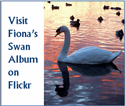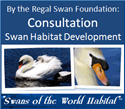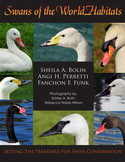Ask the Swan Specialist
Date: 11 January 2012
Hi Dan:
Your situation is a perfect example of why swans need to be penned for at least two weeks when being introduced to a new pond or lake. The birds have absolutely no familiarity with their new caregivers or the boundaries of their new habitat and will go out to explore. If something spooks them, they just keep going. Now, that they know that the dogs chased them from the initial pond area, they will not likely return on their own.
Do not use a throw net as this could seriously harm the swans. You are not going to get close enough to capture them with a net from a kayak. You will need to find an area that you can ease the swans onto land in which you can safely corner them. You will need as many canoes, kayaks or other water vehicles to keep the entire width of the pond or lake contained as you gently herd them to the area that you want to hand capture. If there is a building, fenceline, bushes, etc., that the swans can safely be herded without being injured, this is where they need to be herded, or you can build a temporary pen with poles and poultry fencing (PLASTIC). Just do not herd them into an area that they cannot safely exit the water, i.e., steep embankments, rocky surfaces etc., that can cause them to injure their necks or legs or fences that they can get their necks through but not their bodies which can cause a severe neck injury.
The best solution is the water corral. You will only need to build a temporary corral approximately 10 feet x 6 feet in length and width and at least 4 feet in height to get them inside. Then, four people will need to go inside the corral and hand capture them. There are two ways to capture the swans once they are in the corral, but either method must be done immediately so the birds do not try to force themselves through or against the fencing which can cause them to either escape or get injured.
The first method is to have two nets and two-three people enter the corral. Place a net on each swan and immediately (but gently) grab their legs and necks. Necks and head are grabbed first so that the swan does not drown under the net. Once the head is secured, the legs are gently held (DO NOT hyperextend the legs or you will injure the bird). Now, the swan can be safely wrapped in a towel, sheet or blanket to control its wings and be transported back to the original pond or lake.
The second method is to corner the swan without it being injured or escaping through or over the fencing by gently placing one hand on its wings and gently grasping its neck. This is going to be extremely difficult for anyone who has not previously captured a swan because the swan is going to flail its wings and try to ferociously beat the person. If you do not control the wings, someone or the bird is going to be significantly hurt. So, we would recommend the net method in this case. No matter what, you must consider the safety of the person and the bird while in water.
If you do not think either of these methods will work, you may want to ask a wildlife rehabilitator in your area if they might have a group of individiuals that might be able to assist you in this rescue.
Finally, before you even think about this capture, you will need to build a pen, approximately 6 x 12 feet in length, at least 6 feet in height. Chain link fencing using .09 galvanized to prevent corrosion with 2 inch mesh. The bottom of the fencing (rails) should have poulty fencing (METAL) under the outside railings so that predators cannot dig under and access the pen. The top of the pen must also be reinforced with metal poultry fencing so that predators cannot jump over the fence and into the pen. The outside of the fencing from the bottom rails up to 4 feet should have windscreen. Place this material on the outside of the fencing so that the swans do not suffer a declawing injuring (the claws from their feet being caught in the material and torn from their feet). The windscreen is to prevent them from trying to stick their necks through the 2 inch mesh and getting caught in the chain link fence.
Always remember this tenet when using barriers for swans. IF A SWAN CANNOT SEE THROUGH A BARRIER, IT WILL NOT TRY TO GO THROUGH THE BARRIER. This will prevent many injuries.
Inside the pen, a feeder should be placed (see previous posts on this website regarding how to mount a feeder on a pole in the water for self-feeding by the swans). The swans should be fed 1/2 mixture of cracked corn and 1/2 mixture of poultry layer pellets. You can provide lettuce as a supplemental food source for the aquatic vegetation. Bread should be used sparingly because there is no nutritional content to bread and it can change the bird's blood chemistry. Bread is only to be used as a treat.
If you decide not to use the pen method of introduction, the possibility that the swans will once again, roam back to the other pond that they found will be greatly increased. Now, that the swans know there is another pond in the area, they may seek this pond during the migratory season. Yes, captive swans may have the instinct to migrate. This migration may be due to boredom, curiosity, insufficient food or nesting resources in the present pond, fear of predators or people or the need to migrate during normal migration seasons like their wild swan counterparts.
Fencing can mitigate this roaming. Also, swans are pretty lazy birds and once they are constantly fed, there migration may only consist of migrating to the nearest food bucket or just within the habitat. So, once they are acclimated to the pond or lake, it is imperative that they understand that their food source (YOU) and their normal feeder is very close by and accessible. Again, the swans still may get the urge to roam at sometime whether it be in two weeks, two months or two years, so you need to be cognizant of the possibility and find them immediately.
Swans can roam quickly and for great distances. This puts them in major jeopardy from predation by wild animals, domestic animals, dogs, cats or humans which would intend to harm them. Traffic is another consideration for the need for fencing.
If you can get them to stay on the island by providing a feeder and nesting/bedding material such as straw or reeds, this may keep them somewhat pacified to stay in the area. If the island has a land bridge for predators, this will become an issue. If it is a stand alone island, then the habitat should be perfect as long as their is enough water to serve as a moat and prevent access by predators.
We know that this may all seem overwhelming, but if you can provide a safe, secure habitat with ample food and veterinary medical care when needed, the swans will live a very pampered life and you will receive many hours of enjoyment learning about these beautiful birds. If you should need additional assistance, please do not hesitate to contact us. Please let us know the outcome of this situation. The Regal Swan
Messages In This Thread
- New swans roaming, how to capture -- Dan -- 11 January 2012
- Re: New swans roaming, how to capture -- The Regal Swan -- 11 January 2012
Ask the Swan Specialist is powered by
Tetra-WebBBS 5.30 Beta © 2006-2007 Tetra-Team






